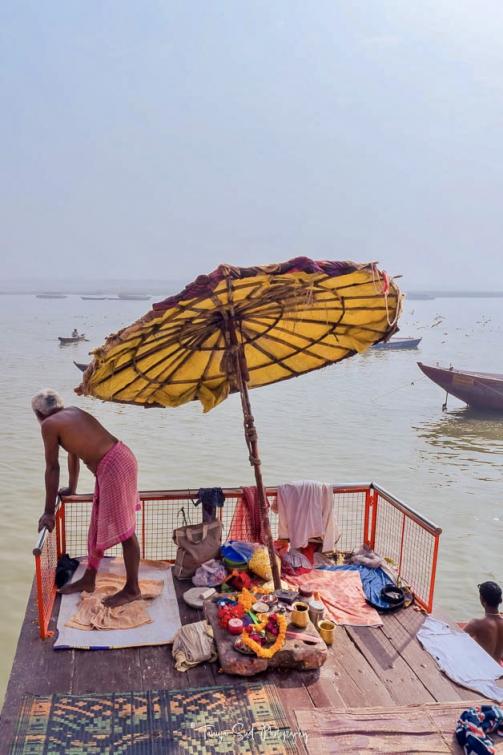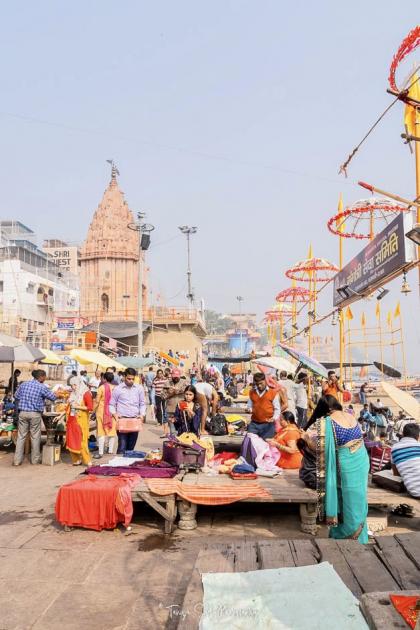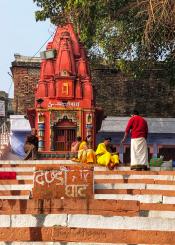Contribute
| The Savvy Traveller WithTanuja Sud - Varanasi |
Tanuja Sud
11/01/2023
India is a land of rich culture, history, and spirituality. Varanasi, often referred to as Kashi or Banaras, is one of the oldest continuously inhabited cities in the world and is considered the holiest city in Hinduism. Located in the state of Uttar Pradesh in northern India, nestling on the banks of the Ganges River, is revered as the most important spiritual city of India. Varanasi is renowned for its ghats, the series of steps leading to the Ganges, where pilgrims and devotees gather for religious ceremonies. The city is also a major hub for Hinduism, Buddhism and Jainism and home to one of Asia’s largest universities, The Banaras Hindu University. Varanasi’s narrow winding lanes, bustling markets, and the spiritual aura create an atmosphere that is enchanting and mystic. No trip to India is complete without visiting this sacred city. I planned a two-day trip to Varanasi in the fall of 2019 while in India to attend a family wedding. After hearing stories over the years from my mom who had made several pilgrimages to the holy city. I was curious to experience the chaos, mystique, and splendor of Varanasi. My daughters and I flew from New Delhi to Varanasi on an early afternoon flight and landed at the newly renovated Lal Bahadur Shastri International airport. The State’s second busiest airport after Lucknow, every major city in the country offers multiple daily flights to Varanasi. There are also multiple trains from Delhi, Mumbai, Kolkata, Agra, and Lucknow serving three major railway stations in Varanasi. Buses run regularly from the state capital Lucknow, Kanpur, Gorakhpur, Khajuraho, Allahabad, and Bodhgaya. Varanasi has plenty of lodging options, from luxury to budget. Some are in the heart of the city and some a few miles away in the quieter part of town. BrijRama Palace hotel is the top choice when it comes to luxury and location. The 200-year-old former palace took 18 years to be restored to its old glory after being bought by the Brij group of hotels. Located right at a ghat, this hotel is the perfect place to stay in Varanasi if budget is not a concern. Other hotels to consider are the Taj Ganges, Taj Nadesar, Radisson, Ramada Plaza and Doubletree by Hilton. We chose to stay at the Radisson Hotel, 4 miles from the old city and close to all the major attractions and loved the hospitality the staff showered on us. We traveled back and forth to and from the old city using Ola cabs (India’s version of Uber) & auto rickshaws. It was cheap, convenient, and safe. After settling into our room and freshening up, we headed to the old city to experience the hustle and bustle. Our Uber driver dropped us off near one of the ghats, and we made our way to Dashashwamedh Ghat, the oldest and most sacred ghat in Varanasi. It is most famous for the daily Ganga aarti, an elaborate and lively spiritual ceremony that takes place at dusk. Our young and enthusiastic oarsman knew the best spots to view the mesmerizing ceremony from the river, so we booked a quiet boat ride. The area was packed with other boats, and it was a remarkable sight to watch young men jump from one boat to the other to sell tea and trinkets to tourists. The Ganga Aarti ceremony in Varanasi is a sacred ritual of devotion to the goddess Ganga, the river goddess who is said to have descended from heaven. It is a time to seek blessings and to express gratitude for her divine presence. The peaceful atmosphere, the shimmering light of the lamps, the sacred chants and music, and the overall spiritual ambiance make the experience truly magical and unforgettable. Day two was reserved for a day trip to Sarnath, located 8 miles from Varanasi and one of the four most important Buddhist pilgrimage destinations in the world. Lord Buddha gave his first sermon at Sarnath. We took an Ola cab from the hotel. The cost of the ride cost us around 500 Rupees. Auto rickshaws and buses are other more budget friendly options to get there. A few must see sights in Sarnath are the Dhamek Stupa complex, where the excavated ruins are located. It is set in a landscaped park and contains the well-preserved Dhamekh Stupa (at the spot where the Buddha is believed to have delivered his first sermon), plus the remains of Buddhist monasteries, the Ashoka Pillar, and Dharmarajika Stupa. The complex is open daily from dawn until dusk. Tickets for foreigners cost 300 rupees (cash) or 250 rupees (cashless). Indians pay 25 rupees (cash) or 20 rupees (cashless). After the Dhamek Stupa complex, our next stop was the Sarnath Archeological Museum, displaying artifacts from the 3rd century B.C .to the 12th century A.D. The impressive top of the Ashoka Pillar is also a highlight. The museum is open daily, except Fridays, from 9 a.m. to 5 p.m. Tickets cost 5 rupees for foreigners and Indians. Photography is not allowed There are a few modern-day temples and monasteries belonging to various Buddhist countries scattered around town. Each has its own architectural style and beauty. The main one is Mulagandha Kuti Vihar. It was built in 1931 by the Sri Lanka Mahabodhi Society in honor of the shrine where the Buddha is said to have sat and meditated in Sarnath. It's open daily from 4 a.m. to 11:30 a.m. and 1:30 p.m. to 8 p.m. The walls are adorned with magnificent art. The Thai temple and monastery are renowned for its 80-foot-tall stone Buddha statue, claimed to be the largest in India. The Chaukhandi Stupa is another major stupa that is in good condition. It marks the spot where the Buddha met up with his five companions. There is an entry fee of 300 rupees (cash) or 250 rupees (cashless) for foreigners and 25 rupees (cash) or 20 rupees (cashless) for Indians. In the late afternoon, we returned to Varanasi and rested at our hotel. Then, we headed to the famous Kashi Vishwanath Hindu Temple, dedicated to Lord Shiva. When we visited in 2019, the temple was undergoing renovations, and the golden dome and other shrines were either cordoned off or covered in scaffolding, so we barely saw them. The Kashi Vishwanath Temple is one of the most sacred Hindu pilgrimage sites and one of the twelve Jyotirlinga shrines, which are said to be abodes of Lord Shiva. Be prepared for large crowds, long lines, and some pushing and shoving by aggressive vendors! Do not be swindled by the vendors selling baskets of flowers and incense as offerings to God. They are overpriced and unnecessary. Due to the immense crowds, devotees are encouraged to keep moving fast, and they barely have a few seconds to stop and pray. We spent the rest of our trip walking around the ghats, wandering through the narrow alleys and lanes, and soaking up the sights and sounds of Varanasi. We saw funeral pyres burning at the Manikarna and Harishchandra Ghats, boats taking tourists for morning rides on the Ganges, people taking dips in the river to cleanse themselves of their sins, and locals going about their daily lives. Despite the chaos and filth, Varanasi is a city that left a profound impression on me, and I hope to return one day. Travel Tips: Best time to visit. Varanasi is best visited in cooler months. November through March are ideal months, while April through July are best avoided. The monsoon season between July and September brings respite from the heat, but I would not recommend traveling to Varanasi during the rainy season. Carry cash Most businesses and small vendors do not take credit cards. Be wary of the Monkeys. They are known to snatch cameras and bags. Do Not Skinny Dip in the Ganges Ditch auto rickshaws in the city and walk Do try local specialties like Aloo Kachori, Baati Chokha, Choora Matar, Tamatar Chaat and Malaiyyo. Do not drink alcohol near holy places. The Uttar Pradesh government has banned sales and consumption of alcohol near temples and holy places. Be respectful of this rule. Wear appropriate clothing. Varanasi is a holy city. You will stand out and feel uncomfortable if you wear revealing clothes. Respect the burning ghats and do not take photos. Beware of swindlers and pickpockets. There are plenty of people out to make a dollar from tourists. Want to take a photo of the snake charmer or the ash smeared sadhu? You can for 500 Rupees. Prepare for cultural shock. You will encounter naked sadhus, beggars, dead bodies being carried through the streets and funerals in the open. Be respectful and do not stare. For more travel information and tips, follow my Instagram account @thesavvytraveller_
You may also access this article through our web-site http://www.lokvani.com/



